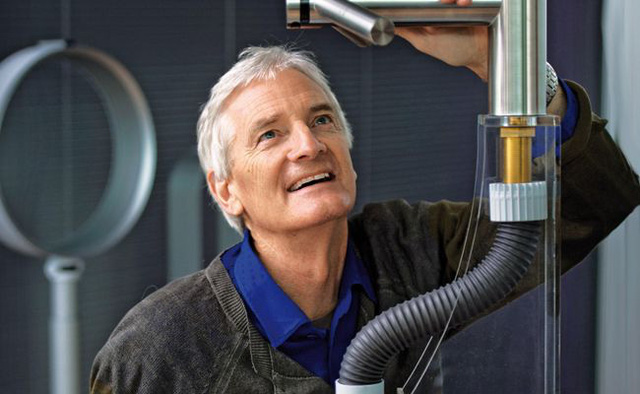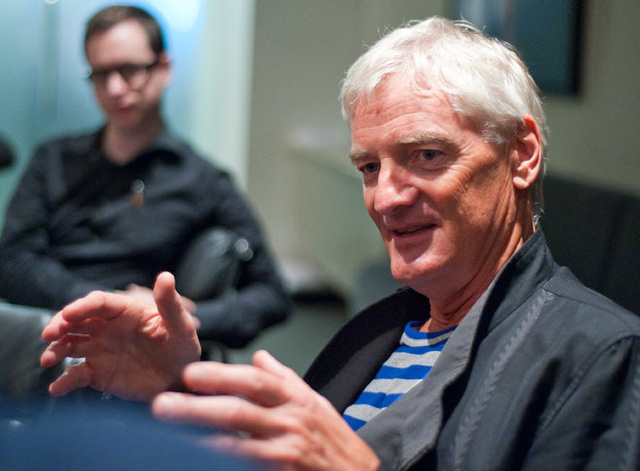After 5,126 times of failures, men create something that is used around the world
- Tram Ho
On January 23, 2019, a ranking of wealthy people showed that: James Dyson founder of Dyson Company – a British technology company, who owns a number of assets worth up to 13, $ 8 billion, becoming the largest person in Britain.
Behind the light was his perseverance, his pursuit of every product.
5126 times failed
Nobody thought that James Dyson – famously known as the “Design King of England” before the invention of the vacuum cleaner – had failed 5,126 times.
James Dyson from a very early age showed off his innate design talent, while studying at the Royal Academy of Art in England, he was famous for inventions such as the “Sea Truck” aircraft carrier and ball-wheeled wheelbarrows. .
On a day when James Dyson was 31 years old, while repairing a vacuum machine on a farm, he discovered that the more dust that was sucked in, the more likely it was that he created a blockage that weakened suction power. .
A man who was dubbed the “technical maniac”, he decided to solve this conundrum, laying the groundwork for the invention of his vacuum cleaner.

James Dyson succeeded in the 5,277th time when he created the G-Force pocket-sized vacuum cleaner in 1983.
Later, James Dyson researched and built more than 100 models, but none succeeded. But he did not give up easily. Despite having to carry a bank loan with high interest, and a debt of 2 million pounds, he also resolutely worked to the end.
Experiencing 5 years of continuous effort, James Dyson succeeded in the 5,127th time when he created the G-Force pocket-free vacuum cleaner in 1983.
But before enjoying the joy of success, James Dyson immediately had difficulty expanding the market.
Stand up from difficulties
At that time, business units in the UK mainly produced high-cost pocket-type vacuum cleaners, the new type of vacuum cleaner invented by James Dyson was not respected and paid attention to.
Faced with great difficulties, his company stood on the edge of bankruptcy.
To solve this situation James Dyson decided to head to the Japanese market, a country with a culture of fascination with home appliances.
Here, his vacuum cleaner was unexpectedly received, consumption increased sharply and won an award in an international design exhibition in 1991.
In 1993, James Dyson decided to once again hit the UK market. He set up a research and development center in the UK, and also through a television advertising campaign called “Say Goodbye to Ball Bags” to attract consumers to buy his vacuum cleaner.

James Dyson.
Also during this time James Dyson always tried to find a new way to develop. He cooperated with Paul Smith – designer of a famous fashion brand and sold dust-free machines right in their stores.
Surprisingly, the amount of vacuum cleaner consumed here is even higher than in stores selling conventional electrical equipment.
Since then, the Dyson-branded vacuum cleaner has gradually taken over the UK market, and these days tend to go global.
With the introduction of bladeless fan, hand dryer using HEPA filters and a series of revolutionary products, James Dyson founded the powerful Dyson empire, which is considered the victory of the wearer. “Productivism” thought.
Steve Jobs of household appliances
James Dyson was dubbed the “Steve Jobs of the housewares industry” because he is very similar to Steve Jobs – all of them are heavily productist.
Currently, despite being over 70 years old James Dyson has always maintained the spirit of an inventor.

He likes “tinkering with” types of models, always capturing and understanding all the company’s projects, most of the time he is in the lab, with engineers conducting various types of testing experiments. Check for the product
He likes going into research but not afraid of failure. “I have not failed, I have just found a myriad of ineffective methods.
Failure is an inventor’s gene, you will never learn anything worthwhile from success but we can do it from failures. ”
Source : Genk
